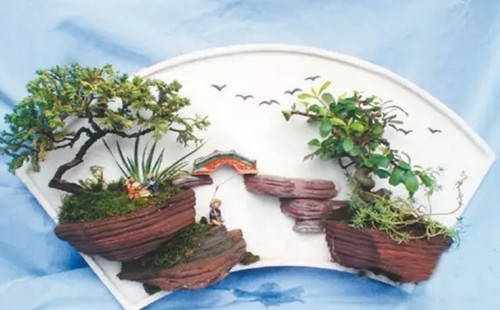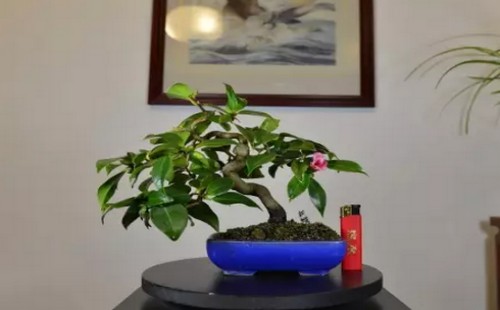The practice of hanging bonsai on the wall
Wall-hanging bonsai is a kind of bonsai style which can be arranged in accordance with vertical requirements, which can be hung up or embedded on the wall. It can often play a good role in decorating and beautifying the environment, which can be described as a fresh three-dimensional painting. In order to improve the appreciation and artistry, the wall-mounted bonsai generally uses marble or disk as the backplane, while the backplane can either set a frame or not. After the backplane is selected, you can stick stones and plant trees and other plants on it, so the three-dimensional sense is very strong and vivid.

However, the wall-hanging bonsai is generally divided into two types of effects: tree-type wall-hanging bonsai focus on the performance of the image of bonsai trees, while landscape-type wall-hanging bonsai with rocks and trees, and even some ornaments, will be integrated into a landscape relief bonsai, not only rich in content, but also full of movement. However, the choice of backplane is often relatively broad, generally using round, oval, rectangular, or even fan-shaped, rich and diverse forms. Next, the editor will share with you the practice of hanging bonsai on the wall.
First, the practice of hanging bonsai trees on the wall
For the bonsai of wall-hanging trees, the volume should not be too large, because after all, this kind of bonsai is mainly to show the beautiful image of the trees, so the flowerpot should be cut in half in a vertical way. Then use a strong glue to stick half of the flowerpots firmly to the backboard, and finally process and shape the bonsai trees planted in the pots. In this process, for the use of the backplane, we first need to solve the problem of firmly hanging, you can drill a few small holes to hang it up with copper hooks.
Of course, if you do not want to use half-wall flowerpots, you can also paste the processed stones on the backplane, but at the same time set aside some caves to plant trees and other green plants. Moreover, a round hole can be drilled on the slate, and the half-wall flowerpot can be firmly glued to the bottom of the round hole on the back of the slate. After removing the soil from the bonsai tree, the root system is pierced from the front of the round hole to the back, and then planted into the half-wall basin.
The main purpose of this approach is to improve the ornamental effect and make the bonsai look more magical and distinctive. The intuitive feeling is that you can only see the trees but not the flowerpots from the front, which is very magical and of great ornamental value. We can even make an artistic inscription on the slate to make the whole bonsai look poetic and dynamic. Of course, if we can choose trees that are more convenient for modeling, we can often achieve the effect of icing on the cake.
Second, the practice of hanging landscape bonsai on the wall
The wall-hanging landscape bonsai generally uses marble as the backplane, and then processes the stone, original and firmly pasted on the backplane, coupled with trees and flowers, which can better reflect the poetic and vivid landscape painting scene. The available stone can be Yingde stone, stalagmite and other relatively hard stone, of course, it can also be used to facilitate processing and modeling of sand stone, seaweed and other types of stone.
In the process of making wall-hanging landscape bonsai, the processing modeling of the stone is generally carried out for the front, while the back is directly cut into a flat plane to facilitate firm pasting on the backplane. And the stone used should not be too thick, because although the stone that is too thick has a stronger three-dimensional sense, it does not look so beautiful as a whole. As the saying goes, "too much is not as good as", so the thickness must be moderate. And importantly, if the stone is too heavy, it will also make it difficult to paste, at least not so firmly.
At the same time, in order to grasp the perspective effect in the process of making a scene, it is generally necessary to achieve the effect of "near mountain, big, clear, far mountain and small blur". That is to say, the stone that makes the close range is larger than the stone that makes the prospect, and the stone lines used in the mountains are clearly visible, while those used in the distant mountains can be blurred, giving people a kind of hazy beauty. A few caves should be reserved on the nearby stone to facilitate the planting of plants, and the outer wall of the stone can be covered with moss to add greenness. Finally, it is embellished with a small amount of accessories to add interest and artistic conception to bonsai.
Time: 2019-06-03 Click:
- Prev

Analysis on the Prospect of miniature Bonsai Wholesale Market
Miniature bonsai is often loved by people for its exquisite plant type effect, although it is relatively small, it is very exquisite, whether it is styling design or maintenance management, it often devotes great painstaking efforts to the creators. So what are the prospects for the miniature bonsai wholesale market? From a personal point of view
- Next

Modeling skills of Landscape Bonsai
Landscape bonsai is a combination of mountains, rocks and plants, but it focuses on the magnificent nature of the mountains and the green of plants, and the effect of coordination between the two, so how to combine them often have to follow certain rules or laws, otherwise the layout will appear more messy, unable to achieve the beauty of nature. meanwhile
Related
- Fuxing push coffee new agricultural production and marketing class: lack of small-scale processing plants
- Jujube rice field leisure farm deep ploughing Yilan for five years to create a space for organic food and play
- Nongyu Farm-A trial of organic papaya for brave women with advanced technology
- Four points for attention in the prevention and control of diseases and insect pests of edible fungi
- How to add nutrient solution to Edible Fungi
- Is there any good way to control edible fungus mites?
- Open Inoculation Technology of Edible Fungi
- Is there any clever way to use fertilizer for edible fungus in winter?
- What agents are used to kill the pathogens of edible fungi in the mushroom shed?
- Rapid drying of Edible Fungi

